>
Holocentriformes (Squirrelfishes, soldierfishes) >
Holocentridae (Squirrelfishes, soldierfishes) > Holocentrinae
Etymology: Neoniphon: Greek, neos = new + Greek, niphon = to snow (Ref. 45335).
More on author: Cuvier.
Environment: milieu / Klimaatzone / Diepte / distribution range
Ecologie
marien rifbewoner; diepte 1 - 70 m (Ref. 9710), usually 30 - 60 m (Ref. 9710). Tropical; 27°N - 10°N, 85°W - 60°W
Western Atlantic: Florida Keys, USA and Bahamas to Trinidad. Antilles and throughout Caribbean (Ref. 26938).
Grootte / Gewicht / Leeftijd
Maturiteit: Lm ? range ? - ? cm
Max length : 18.0 cm TL mannelijk / geslacht onbekend; (Ref. 26340)
Dorsale stekels (totaal) : 11; Dorsale zachte stralen (totaal) : 12 - 14; Anale stekels: 4; Anale zachte stralen: 9. Body striped with red, yellow and silver; often anterior third of body more yellow than remainder. Third anal ray spine very long and stout (Ref. 26938). Body slender, spiny dorsal fin with broad yellow band along middle and lower sides (Ref. 37108).
Body shape (shape guide): fusiform / normal.
Rarely found in shallow water, but appears to be the most common squirrelfish in the depth range of 30-60 m or more (Ref. 32). Reported used as food fish (Ref. 37108).
Levenscyclus en paargedrag
Maturiteit | Voortplanting | Paaien | Eieren | Fecunditeit | Larven
Böhlke, J.E. and C.C.G. Chaplin, 1993. Fishes of the Bahamas and adjacent tropical waters. 2nd edition. University of Texas Press, Austin. (Ref. 5521)
Status op de Rode Lijst van het IUCN (Ref. 130435: Version 2025-1)
Gevaar voor de mens
Harmless
Gebruik door de mens
Visserij: van minder commercieel belang
Tools
Speciale rapporten
Download XML
Internetbronnen
Estimates based on models
Preferred temperature (Ref.
123201): 23.7 - 27.7, mean 26.6 °C (based on 29 cells).
Fylogenetische diversiteitsindex (Ref.
82804): PD
50 = 0.5039 [Uniqueness, from 0.5 = low to 2.0 = high].
Bayesian length-weight: a=0.01585 (0.00766 - 0.03278), b=2.97 (2.79 - 3.15), in cm total length, based on LWR estimates for this (Sub)family-body shape (Ref.
93245).
Trofisch niveau (Ref.
69278): 3.6 ±0.4 se; based on diet studies.
Weerstandsvermogen (Ref.
120179): Hoog, minimale populatieverdubbelingstijd minder dan 15 maanden (Preliminary K or Fecundity.).
Fishing Vulnerability (Ref.
59153): Low vulnerability (10 of 100).
🛈
Nutrients (Ref.
124155): Calcium = 82.3 [37.2, 256.7] mg/100g; Iron = 0.795 [0.331, 1.616] mg/100g; Protein = 18.5 [17.3, 19.7] %; Omega3 = 0.18 [0.07, 0.43] g/100g; Selenium = 36.2 [21.2, 69.5] μg/100g; VitaminA = 76.3 [29.6, 206.6] μg/100g; Zinc = 1.5 [1.0, 2.3] mg/100g (wet weight);
